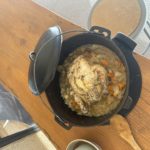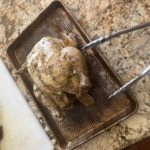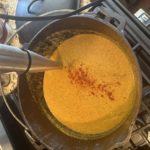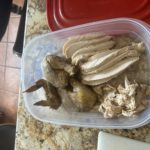This one of my favorite uses of my old black iron Dutch oven (DO). I’m sharing a recipe (guideline) that has no predetermined quantities or measurements. It’s different each time I make it. Today, I’m starting with a 5-pound chicken but any size whole chicken is just fine. Here’s how I do it……
Take out all the giblets that might have been shipped with the bird. Place the bird in a bowl or pan to facilitate seasoning.
Season the bird in a bowl or pan with your preferred seasoning mix. I keep it very simple with an alder wood smoked salt and a special house-ground pepper mix and liberally coating the bird with the skin still on. If time permits, cover and throw the seasoned bird into the fridge for a couple of hours to let the seasoning permeate the bird. However, I haven’t been able to detect a major improvement if flavor either way. Brining is another great option, but I generally only do that with smaller pieces that are going on the grill and moisture retention is desired.
Rough chop 1 large white onion and a head of garlic and stuff the cavity with as much of the mixture as possible. I keep this simple and add aromatics like bay leaves, sage, thyme, rosemary, etc. later as you’ll see below. Sew up the cavity with toothpicks or cooking string to keep everything inside while cooking.
Place a few tablespoons of a “high heat” oil (I use canola) in the DO and start heating on medium to high heat. Use just enough oil to keep the bird from sticking to the bottom while executing the next step. After the oil is hot, sear each of the 4 sides of the bird to brown the skin and activate the fat and the seasoning mixture. After searing, place the bird on its back and reduce heat to low. Here, I add about a cup of water to the DO and put on the lid. Chicken stock is also good.
As cooking starts and in preparation for a variation on a sweet potato gravy, cut up another whole onion and a couple of bell peppers (I like the brightly colored ones as I think they are sweeter). Then rough chop a couple of medium sized sweet potatoes that I needed to use so I tossed them in to add some thickness and sweetness to the gravy. Obviously, carrots could be used if sweet potatoes were not available. Set this material aside for a moment.
Now, assemble some aromatics. I use sage, thyme, and rosemary (I have it growing in the garden) and add a few bay leaves. Add other herbs per your preference. I do not chop these. They are easier to remove whole before final mixing of the gravy later.
Next, add the chopped peppers, additional onion, sweet potatoes, and the aromatics around the bird in the (DO). You can add about 1/2 of the aromatics at the start of the cooking process and then add the other 1/2 about an hour into the cooking process. Sometimes, I’ll even throw the rest in during the final few minutes of cooking and remove it all after the bird cools down later. Aromatics seem to affect the flavor more if added later in the process. I cannot testify that it makes a significant difference so use your own judgement. The veggies I’m adding are for making gravy. However, if you decide to add veggies that you intend to plate up for your customers, consider adding them at the end of the cooking process so they don’t turn to mush.
Cook on low for about 1.5 hours to ensure complete heating of the internal mixture. A meat thermometer should be used to confirm the internal temperature at least 165 degrees. Continue cooking until the proper temperature has been confirmed. Any stuffing in the bird must also be up to that temperature. Then, just let it sit and cool until you can handle the bird. I leave the lid on the DO while cooling it outside for at least 2 hours on the back porch. The mixture will continue to cook and the flavors will continue to synergize during the couple of hours this will take to cool.
After cooling, use tongs to remove the bird from the pot and place in something that will contain any juices but will allow you to slice the bird. Don’t let any juice escape! Open the cavity and empty the onion and garlic back into the (DO). Then, remove the skin from the main body section and place in a skillet. Set the bird aside for now. Some of the skin on the back might be stuck to the bottom of the DO. Use a scraper to get all that you can. Use medium to high heat to “cracklinize” the skins. Essentially, you are refrying the skin to produce cracklins. When the fat from these skins has been rendered out, remove, and drain the skins. Some salt might be required. After they cool, you can chop these into small pieces to be used later. They will look very much like bacon bits. These are a flavor gold mine and can be used in a variety of dishes in the future. I use kitchen shears to reduce the pieces to a small size. This seems to help them cook more thoroughly. It only takes a small amount of cracklins to add a real flavor kick to anything including soups, beans, mashed potatoes, etc.
Now, it’s time to prepare the bird for serving. You can cut/part-out the bird as per your preferences. I usually remove the wings, legs, and thighs whole (bone-in) and slice the breast into about 1/4″ slices. All the remaining bones and left over pieces are also the sole property of Gracie – our border collie. Refrigerate the meat that you are not going to serve immediately.
Once the bird is out it’s time for the sweet potato gravy. I remove any woody aromatics and the bay leaves (if you can find them) and use a hand blender to puree the remaining contents of the DO to a very smooth gravy. Add back any juice/broth that comes from the slicing of the chicken. If you feel like the gravy is too thin (not likely) you can use the corn starch thickening method, or a traditional flour roux as would be typical in Louisiana or thereabouts. I usually just count on the pureed veggies as a natural thickener and cook down the gravy until it’s at the consistency that I desire.
The gravy may be perfect with no further additions or cooking. However, it is not spicy so a shot or two of LA hot sauce, creole seasoning, cayenne pepper or smoked paprika, cumin, or all of the above (the sky is the limit) can add some great zest to the gravy. It’ll also have a good bit of chicken fat in it. Cooling overnight in the fridge will make the bulk of the fat rise and form a layer in the container. If desired, this can be scooped off and well, this usually becomes the sole jurisdiction of Gracie. Mixing this excess fat with her dried food makes her so happy that she humps my leg! She’s a very sick pup.
I store the gravy and the meat separately for ease of use later. You will have a lot of leftover gravy which I would consider for future dinners or a base for a soup. In fact, this gravy reminds me of a fall butternut squash soup.
Serve the chicken with some sweet potato gravy and sprinkle a generous portion of cracklins over the top. Our favorite side dishes are red beans, rice and avocado. Green veggies and mashed potatoes are also a fan favorite. Some additional LA hot sauce is a must for me to lend more excitement to the whole affair. We usually pair this with a bold red wine like a cabernet sauvignon or a French Bordeaux or a brown (or darker) ale. For white wine enthusiasts, maybe a good chardonnay?
Ingredients list (quantities are approximate) for consideration:
1 Whole chicken
1 Sprig of rosemary
1 Sprig of sage
1 Sprig of thyme
3 Bay leaves
1 Head of garlic
2 white onions
2 sweet potatoes
2 bell peppers
To taste:
Salt
Pepper
Smoked paprika
Cayenne pepper
Cumin
Cajun seasoning (optional)




